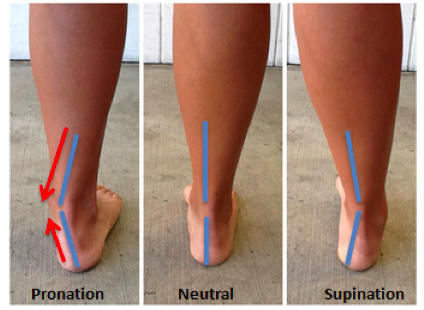As a physical therapist, I love treating the foot and ankle. Those 30 beautiful bones are anything but standard. Just like we have different noses and earlobes the shapes and sizes of our bones vary greatly. Many, many times I have heard someone say “I’m a pronator “or “I’m a supinator” and want to know if that’s why they hurt. A little anatomy lesson is needed first.
Defining Pronation and Supination
Pronation and supination are not good or bad. They are simply terms used to describe motion. For example, at the subtalar joint (joint below the ankle) pronation occurs during walking when the heel bone/ calcaneus swings out as weight is accepted by the leg. At the same time, the talus (bone in the middle of the ankle) adducts/gets closer to the midline and plantarflexes/points down. There are several joints past this that move in response. Supination is the opposite of this and occurs when our heel first touches the ground and then occurs again right before pushing off. It's pretty easy to see why a term was created so we don’t have to say that mouthful of words each time! Only podiatrists and PTs need to know all that level of detail. It is included here only to highlight how complex the foot really is. Here is a friendlier definition:
During supination, our foot is a rigid lever, sometimes referred to as “locked” which is perfect for heel strike and the push-off phases of gait. During pronation, our foot is “unlocked “so it can adapt to varied ground surfaces.
Pronation and supination become a problem when they occur at the wrong time, occur too quickly, or occur in excess. This can happen when our muscles lack appropriate strength and timing but can also occur when the movement ratios of our joints are less than ideal. This is the job of a PT to sort out. For example, inner ankle pain can be from a fallen arch created by poor joint movement ratios or can be from lack of strength in the Posterior Tibialis muscle. These are not the only causes of inner ankle pain, just common examples.
Inserts
Strengthening our muscles to serve us at the right time is frequently enough. However, if the movement ratio is significant enough, a person then requires good inserts(store-bought) or orthotics( made by a podiatrist or a prosthetist). There are a lot of inserts on the market that are of poor quality. You shouldn’t be able to press the arch of the insert down with your thumb more than a 1/3. If your thumb can flatten it, body weight doesn’t stand a chance. Arch support should always fill the arch except for a shadow. If an insert overfills the arch it will push you to the outside of your foot. Inserts with a heel well are ideal as these start your heel in a more neutral position. Inserts only work properly in a shoe that meets the following stability criteria:
The first is that the toe break in the shoe does not extend into the sole of the shoe. A toe break is where the shoe bends when you’re pushing off the ground as you walk. The second feature is that the shoe cannot be bent in half and is solid on the back and sides of the heel.



